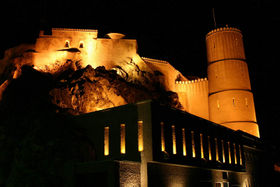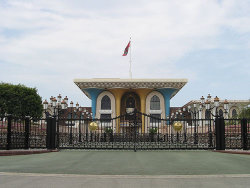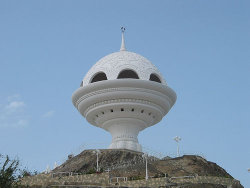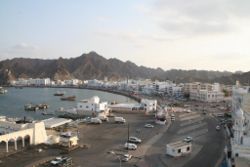Muscat, Oman
2007 Schools Wikipedia Selection. Related subjects: Geography of the Middle East
|
|||
| Classification | City | ||
| Sultan | Qaboos bin Said al Said | ||
| Area | 3,500 km² | ||
| Population - Total ( 2005) - Density - Oman calculated rank |
606,024 184.57/ km² 1st |
||
| Timezone: | ( UTC) +4 | ||
| Latitude Longitude |
|||
| Official website: http://www.omanet.om | |||
Muscat (Arabic: مسقط Masqaṭ, IPA: [mʌsqʌtˁ]) is the capital and largest city in the Sultanate of Oman. It is the largest city in the mintaqah ( governorate) of Muscat (sometimes referred to as Masqat to differentiate it from the city). The city of Muscat has a 2005 estimated population of 600,000 .
The greater metropolitan area of Muscat, known locally as the 'Capital Area', currently covers an area of approximately 1500 km². Since Oman's 'Renaissance' of modernization began in 1970 (see below), Muscat has seen an explosion of infrastructure development and urbanization, and, as has been the case in so many other cities worldwide, towns which were once distinct have been subsumed within the sprawling growth of the city's expanding metropolitan area. Pockets of dense residential and commercial districts are interspersed with undeveloped land. The major centers of development can be split into three main groups:
- West Muscat: Al-Seeb, Udhaybah, Bawsher, Al-Ghubbrah and Ghala
- Central Muscat: Al-Khuwair, Madinat Al Sultan Qaboos, Shati-Al Qurm, Qurm and Ras Al Hamra
- East Muscat: Wuttayah, Ruwi, Matrah, Kalbuh, Old Muscat, Sidab and Al-Bustan
In general, Muscat presents a relatively homogeneous appearance of low (rarely more than five story), generally white buildings, with residential, government, and commercial architecture frequently recalling, at least by allusion, historic regional styles. For a city at the edge of the Arabian peninsula and in Oman's sometimes fierce climate, Muscat is remarkably green, with tree-lined main streets linking the various districts, several sizeable public parks, and grass, shrubs, and flowers decorating many traffic circles and other public areas.
The IPA transcription of the city's Standard Arabic name is /mʌsqʌtʕ/. The pronunciation is sometimes approximated in English as /'mʌskæt/, /'mʌskɛt/, or /'mʌskət/ (homophonous with "musket").
History
Muscat is one of the oldest cities in the Middle East. It has been known since the second century AD. Some 3,000 pounds (1,400 kg) of frankincense was transported each year by ship from southern Arabia to Greece, Rome and the Mediterranean. The centre of this trade was in a place called Khour Rouri, which the Greeks called "Muscat". (Note that Khour Rouri is now recognized as an archaeological site in the Dhofar region of the country, more than 500 miles south of present-day Muscat, far closer to the present-day city of Salalah).
The first foreign presence in Muscat was in the form of the Portuguese explorer Vasco da Gama, who landed in Oman on his way to India. The Portuguese returned in 1507 to sack and capture Muscat. In 1649, the Imam Sultan bin Saif defeated the Portuguese under André Pereira dos Reis and drove them away east to Goa, India.
With the superior, captured warships of the Portuguese navy, the Imam established an empire that spanned from Zanzibar in the south to Gwadar in Pakistan in the east. Slaves were brought in from Zanzibar and Balochistan to work in Oman and traded elsewhere. This was a period of relative stability and prosperity in Muscat and Oman.
The country was torn apart by strife and unrest upon the death of the Imam in 1679. Muscat was then invaded by the Persians in 1737, albeit briefly, since Admad bin Said defeated them and was subsequently elected Imam.
In 1803, the Wahabbis of Saudi Arabia attacked Oman, but were repulsed by Sayyid Said bin Sultan. The sultan then set up a colony in the fertile areas of Zanzibar and essentially ruled Oman from a foreign island. Later, in 1853, the Sultan transferred the title of "capital" of Oman to Zanzibar. Thus began to decline of the fortunes of Muscat and Oman.
In 1913, Sultan Taimur bin Faisal became Sultan and the territory was renamed "Muscat and Oman" with the Sultan ruling Muscat and the Imam ruling Oman. After Indian independence in 1947, the Sultan, with the help of the British, defeated the Imam, unified most of Oman taking command of the Buraimi oasis.
The Dhofar War began in 1964 which was a communist insurrection staged from the Peoples Democratic Republic of Yemen against the Sultan of Oman. The insurrection was opposed by Omani, British and Iranian forces and was successfully put down. Six years later, Prince Qaboos bin Said, son of Sultan Said bin Taimur staged a palace coup and claimed the throne. The old Sultan was flown to London by the British Royal Air Force. The coup, staged by Prince Qaboos, with his close friend and confidant Tim Landon at his side, was the beginning of a new consolidated, modern sultanate.
Economy
Muscat, like much of Oman, is dominated by trade. The more traditional exports of the city include dates, mother of pearl, frankincense and fish. Many of the souks of old Muscat and Muttrah sell these items and traditional Omani artefacts.
Petroleum Development Oman (PDO) has been central to Muscat's economy since at least 1962 and is the country's second largest employer, after the government. PDO's major shareholders include Royal Dutch/Shell, Total, and Partex and its production is estimated to be about 720,000 barrels per day.
Muscat also has major trading companies such as Suhail and Saud Bahwan, which is a trading partner for corporations such as Toshiba, Subaru, Seiko, Hewlett Packard, General Motors; Saud Bahwan Group whose trading partners are Toyota, Daihatsu and Hertz Rent-a-Car; and Zubair Automotive whose trading partners include Mitsubishi, and DaimlerChrysler brands such as Dodge.
Mina Sultan Qaboos, Muscat's main trading port, is an important trading hub between the Persian Gulf, the Indian subcontinent and the Far East with an annual volume of about 1.6 million tons. However, the emergence of the Jebel Ali Free Zone in neighboring Dubai, United Arab Emirates, has made that port the premier maritime trading port of the region with about 44 million tons traded in cargo annually.
All infrastructural facilities are owned and operated by the government of Oman. Oman Telecommunications (Omantel) is the major telecommunications organization in Oman and provides local, long-distance and international dialing facilities and operates as the country's only ISP. Recent liberalization of the mobile telephone market has seen the establishment of a second provider: Nawras
Society and religion
Omanis constitute about 60 percent of the local population. Muscat has a sizable expatriate population, mainly in the form of skilled and unskilled workers from the Indian subcontinent, the Sudan, Egypt and other GCC countries.
Arabic is the official language of the state. Swahili, English, Hindi and Malayalam are widely spoken.
Most of the city's residents are followers of Islam, the Sultanate's only recognized religion. 75 percent of the people are Ibadi Muslims. Muscat also has foreign minorities of Hindus and Christians. Oman allows non-Muslims to practice their religion, but they may not proselytize publicly or distribute religious literature. The city has two Hindu temples — a Shiva temple and a Krishna temple, and a Saints Peter & Paul Church in the city's Ruwi locality.
Transport
The main airport is Seeb International Airport around 25 km from the city's business district of Ruwi and 15 to 20 km from the main residential localities of Al-Khuwair, Madinat Al Sultan Qaboos, Shati Al-Qurm and Al-Qurm. Muscat is one of the three headquarters of Gulf Air and the headquarters for the local Oman Air, both of which fly to several destinations within the Middle East, the Indian Subcontinent and East Africa. In addition, Gulf Air flies to select destinations in Europe, Great Britain, North Africa and East Asia. Other airlines such as British Airways, Lufthansa, Emirates, Swiss International Air Lines, Kuwait Airways, Air India and Thai Airways also fly through Seeb International Airport.
The Muscat area is well serviced by paved roads and dual-carriageway connects most major cities and towns in the country.
Public transportation in Muscat, and Oman in general, leaves much to be desired. There is no rail or metro network in the country. Several forms of public transport are popular in Oman. Most popular are the "Baiza" buses, so named for the lower denomination of the Omani Rial, the baisa (an adaptation of the Indian lower denomination paisa). These are relatively inexpensive and service all major roadways, as well as a wide and loose network of smaller byways in the greater Muscat metropolitan area, opportunistically dropping off and picking up passengers at any location. Less popular and slightly more expensive are large public buses, coloured red and green, whose service is limited to major roadways and point-to-point travel routes between Oman's major cities and towns. Taxis, also colour-coded orange and white, provide semi-personal transportation in the form of both individual hire and the same opportunistic roadway service as Baiza buses.
Baiza buses and colour-coded orange-and-white taxis are unmetered, after several government initiatives to introduce meters were rejected. The fare is set by way of negotiation, although taxi drivers usually adhere to certain unwritten rules for fares within the city. In many countries, one is advised to negotiate a fare with the driver before getting into a taxi. However, in Oman, asking for the fare beforehand often demonstrates a passenger's newness and unfamiliarity with the area. One should always find out the normally accepted fare for one's journey from one's hotel or host before looking for a taxi.
Unlike in some other wealthy countries in the Gulf, taxi and bus drivers in Oman are exclusively Omani nationals.
Taxis will also generally take passengers to locations out of the city, including Sohar, Buraimi and Dubai.
Administrative Divisions
Muscat governorate consists of six wilayats: Muscat, Mutrah, Bawshar, Seeb, Al Amerat and Qurayyat.




